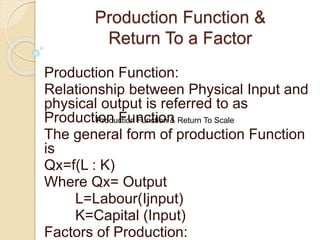
Production Functionand Law of Variable Proportion
- 1. Production Function & Return To a Factor Production Function: Relationship between Physical Input and physical output is referred to as Production Function The general form of production Function is Qx=f(L : K) Where Qx= Output L=Labour(Ijnput) K=Capital (Input) Factors of Production: Production Function & Return To Scale
- 5. The Concept of Total Product Marginal Product and Average Product Total Product: •TP is the sum total of output of each unit of the variable factor used in the process of production. •It is also called total return of the variable factor. A producer with some fixed factor uses 1 to 6 units of variable factor (labour) and resultant output is 10,12,15,12,10,8 units of commodity. TP = 10+12+15+12+10+8
- 7. Marginal Product: • MP refers to change in TP when one more unit of the variable factor is used where as fixed factors remains constant. MP=Change in Output/Change in input = Q / L Since Fixed Factors are constant and L =1 Also Q= TPn -TPn-1 MP or MPnth =TPn -TPn-1
- 8. Marginal Product: The Marginal Product of an input shows the increase in total output from a one unit increase in the amount of the variable input
- 9. Average Product The Fixed Factors being constant average product of an input is per unit product of variable factor. AP = Total Product/Unit of Variable Factor = TP/L
- 11. Relationship Between MP and AP AP & MP Graphical Example Points to Note: • When AP is rising it is always less than MP and when it is falling it is always greater than MP. •MP = AP when AP is at its max. •MP = 0 when TP reaches its max and •AP = 0 when TP = 0 Law of Diminishing Returns
- 12. Law of Diminishing Returns The law of diminishing returns states that as a firm uses more of a variable input without changing the quantity of fixed inputs, the MP of the variable input will eventually decline. Why? • Because the productivity of additional units of the variable input (Labor) is limited by the lack of the fixed input (machines). This is the reason for the shapes of the TP, AP & MP curve.
- 13. Consider a factory with 10 jean machines. Suppose one machine can be used by one worker. The first ten workers can each have a machine. The next few can carry raw materials for those on the machines. However eventually you get to a point where additional workers are just standing around getting in each others way. Eventually the MP of each additional hour worked will decline due to the bottleneck in the number of machines. • The law of diminishing MP is the reason • For example:
- 15. The relationship between TP and MP MP tends to rise till OL units of Labour are used (optimum). The corresponding point E on the MP curve. This is the situation of increasing returns to a factor. When MP is increasing TP increase with increasing rate. This occurs till point B on TP curve. This corresponds to the situation of increasing return to Factor. Beyond OL MP tends to decline. Corresponding to it TP increases with decreasing rate. This occurs between E and F point on MP curve and B and C point at TP curve. This is the situation of diminishing return to a factor. When employment of labour exceeds OL units, MP becomes negative. Accordingly, TP starts declining. It is the situation of Diminishing returns to a factor. It occurs beyond point C on TP curve and beyond point F on PM curve.
- 16. Causes of Increasing Returns to factor: Fuller Utilisation of the Fixed Factors. Increased efficiency of the variable Factors. Better coordination between the Factors Causes of Diminishing Returns to a Factor Fixity of the Factor(s) Imperfect Factor Substitutability. Poor coordination between the Factors. Assumptions of the Law of Variable Proportions: Ratio in which factors of production are combined can be changed. Units of the variable factor are homogeneous State of Technology does not change.